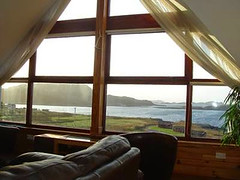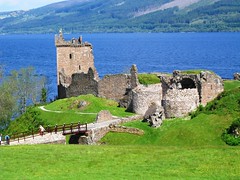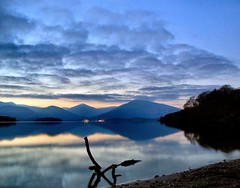Corbetts Completion
CORBETT'S COMPLETION
John Rooke Corbett is thought to have completed the amazing feat of climbing all of Scotland's 2000ft hills. Dave Hewitt thinks this may be a mistake in history but nonetheless Corbett is one of his favourite characters.
Maybe it's the sceptic in me, but I'm interested in those statements and traditions, which if subjected to even a few seconds of scrutiny, prompt a realisation that they're almost certainly utter nonsense. Take, by way of example, the oft-heard belief that the age of a cat is one-seventh that of a human. Loads of people take this as an absolute, handed-down truth, such that if encountering a cat aged, say, eight, they'll do the mental arithmetic and volunteer that it's actually 56 in "our" terms.
Well, they might be able to do sums but they can't do logic. It doesn't take much to discover that domestic cats routinely live to age 15, quite often up towards 20. (A blind Siamese round the corner from us died earlier this year aged 21 - and, while its owners were aware that this was a good innings, they weren't phoning the Guinness world records people.) If 15 is taken as the benchmark, then 7x15 = 105: an age which hardly any humans reach. The real "conversion" figure, if such a biologically tenuous idea is to be invoked, is surely five, with six as an absolute upper limit. Seeing a 15-year-old cat as the equivalent of a 75-year-old human is reasonable; seeing it as a centenarian and then some is laughable. But still people trot this out, often educated, seemingly numerate people, and I suspect that when I eventually die aged 147 the tradition will be just as strong as ever.
I mention this because of the following statement, included on page 6 of the new SMC Corbetts guidebook (The Corbetts and other Scottish hills), "[Corbett] completed the Munros and Tops in 1930, only the second person to do so and, more remarkably, he climbed all Scotland's 2000ft hills." Now the first part of this is fine - John Rooke Corbett did indeed complete the Munros and Tops in 1930 - in June of that year to be more precise (although, as with so much concerning Corbett's life and hill career, the exact date hasn't yet been pinned down). The finish came on Buachaille Etive Mor and his eventual obituarist S F "Mac" Forrester (writing in the 1950 Rucksack Club Journal) noted that Corbett claimed he was unable to celebrate properly due to having left "a sister and two maiden aunts in the car".
So that bit is correct. The problem comes with the assertion that "he climbed all Scotland's 2000ft hills." This might be true - with a hefty italicised emphasis on might - but I strongly suspect it's not. As with the cat example, think for a moment what is actually being said here. Perhaps the easiest way to do this is to compare the statement with its most commonly heard equivalent - that so-and-so climbed all of England's 2000ft hills. This latter feat is an eminently manageable target - not trivial, but hardly a life's work. In terms of what it means, definition-wise, it usually involves all English summits above 2000ft/610m in height with a specified drop, commonly 100ft or 30m.
The first person to achieve this appears to have been W T Elmslie, who completed a list of 348 summits on 25 November 1944. Next came Ernest Moss (who had published his own version of the English list in the Rucksack Club Journal of 1939). Moss completed on 22 July 1951, and was followed by Clem Clements on 30 May 1953 - the day after the successful completion of a rather better publicised hill enterprise a few thousand miles to the southeast. Then came A St G Walsh, another who worked from his own list (see the Wayfarer's Journal, 1950) and who finished on the not-really-English Snaefell on the last day of 1953. There might have been others in the gaps between these four, there might have been someone ahead of Elmslie; but the point is that this list, in its various forms, was completed pretty early in proceedings. It was do-able, and it was done.
Applying this same 100ft/30m drop criterion to the Scottish 2000ers opens a few floodgates, however, as a claim to have climbed all the hills requires: (a) Munros and Tops - well, let's be generous and count only those Munro Tops with 30m drop, ie 455 summits; (b) the Corbetts and their associated tops: 669 of these; and (c) the Grahams and their tops. Alan Dawson, Clem Clements (happily still with us and due to enter his ninth decade next March) and I are working on the list of Graham Tops, and hope to publish sometime mid-2003. We don't as yet have an exact figure, but it looks like around 1000 hills are involved. So, using the English model, anyone climbing the Scottish 2000ers needs to visit in the region of 2100 summits.
As things stand, only one person is known to have climbed all the Corbett Tops: James Gordon, who completed on Marg na Craige above Laggan on 24 February this year. He has also been round Munros, Munro Tops and Grahams, so has done a lot of legwork, but is still lacking around one third of the full Scottish 2000er set, due to his not (yet) having tackled the subsidiary Graham Tops. The great Colin Dodgson (died 27 July 1991) visited a similar number of hills during a lifetime spent working through Willie Docharty's books of tables (published 1954 and 1962); but, despite being the most prolific British hillbagger of the immediate postwar period, it doesn't appear that Dodgson got close to the all-the-2000ers finishing-line, either.
It thus seems scarcely credible that Corbett could have climbed all the hills in question, so let's make the requirement easier. Let's just say that climbing "all Scotland's 2000ft hills" can be claimed if a much less rigorous drop criterion is invoked. The obvious choice is the traditional 500ft/150m requirement, under which "all Scotland's 2000ft hills" would be applicable to anyone who has been round Munros, Corbetts and Grahams.
Corbetts are defined by 500ft of all-round drop, Grahams by the slightly less strict 150m, but only 205 of the current 284 Munros have separation on this scale. So the least-strict definition of "all Scotland's 2000ft hills" could be said to equate to 205 Munros plus 219 Corbetts plus 224 Grahams, ie 648 summits. Let's call it a round 650 to accommodate the various map/height changes since Corbett's time.
This is a far less arduous task than the 2100-odd summits of the 30m-drop rule, and has been shown to be manageable. At the time of writing only 20 people are known to have completed the Grahams (see list here - the most recent finish came from Mike Dixon of the Inverness Mountaineering Club on Beinn a'Chearcaill, 17 November). Of these 20 Grahamists, all bar two have also completed Munros and Corbetts, ie have been up all the 650-odd hills in question. So this, like the English 2000ers, can be done - and the first person to achieve it appears to have been Dodgson, who wrapped up the Docharties (the forerunners of the Grahams) with Beinn a'Mhuinidh on 4 July 1984.
The question is, could John Rooke Corbett, who died on 13 August 1949 having been relatively inactive in his final years due to ill-health, have completed this threefold set of hills some 40 years before Dodgson? If so, then the statement about his 2000ers can be seen as correct (or at least valid: speaking with various modern-day compleaters, it's clear that climbing these 650 hills doesn't lead them to think they've completed the set of Scottish 2000ers).
Corbett was the Dodgson of his time, a man about whom the phrase "the greatest walker of his generation" was used with justification. Indeed, there is scope for a succession to be drawn up for this title, with only a few genuine candidates in any given period - Corbett / A W Wakefield / Eustace Thomas prewar, then Dodgson / Willie Docharty / Philip Tranter / Anne Littlejohn through until the 1970s, then Ann and Rowland Bowker, Hamish Brown, Charles Knowles and Phil Cooper through the 1970s and 80s, and the likes of Rob Woodall and Ken Whyte in the modern era. Each of these periods will have seen other candidates, including unpublicised walkers whose names we'll never know, but if the "greatest walker" title goes to an eclectic hillgoer with an appetite for completing any list that comes their way, then these names are among those which must come into consideration.
So Corbett was a great walker, but that doesn't answer the question. The way to tackle this is to find out where the "all Scottish 2000ft hills" phrase came from - which brings us to the 1950 SMC Journal's obituary of Corbett, written by Robin Gall Inglis. It was an affectionate tribute - "The well-known, kindly face of J Rooke Corbett will no more be seen in our midst; a giant among hill lovers has made his last ascent..." - and included two phrases of specific relevance here. The first is this: "It is not likely that his record of Scottish ascents will ever be broken." The second - which surely gave rise to the 2000er phrase in its present form - is this: "Not long before the heart attack, in 1943, that ended his climbing but happily not his walking days, he accomplished a long-cherished ambition of completing the ascent of every 2000-foot eminence in Scotland."
This appears to be even clearer than the current version and - if true - leans more towards the 2100-summit option than to the easier Munros plus Corbetts plus Docharties/Grahams alternative. The phrase has been quoted a time or two (eg see page 80 of Robin N Campbell's The Munroist's Companion), and appears to take its current form via Hamish Brown, who in the introduction to his Climbing the Corbetts wrote: "[Corbett] also made the ascent of every 2000-foot hill in Scotland, still a very rare feat."
Crucially, we're not hearing the voice of Corbett himself. Some of his hill-related papers were handed to the SMC after his death, and it was the editing of these which led to the modern list of Scottish 2500ft hills. These papers have disappeared however, and although I've been asking around SMC sources, nothing has come up as yet. If and when the papers do resurface, things should become much clearer. What must be said is that there's no suggestion of Corbett having made any kind of dishonest claim - he was noted for his thoughtfulness and integrity, and came from Quaker stock (and after several years of researching his life and hill career, he's become my favourite hill character from that era, the one I would most have liked to have met).
So only two possible conclusions are likely. It could be that the claim will be borne out by evidence - that Corbett did indeed visit hundreds of unsung 2000ft hills across Scotland. Far more likely however is that a mistake was made in transcription (and/or in comprehension) circa 1950, and that "all Scottish 2000ft hills" should actually read "all Scottish 2500ft hills".
This would make much more sense. Hills in the 2500ft-2999ft bracket were Corbett's speciality, and he had been detailing them for years, initially in the Rucksack Club Journal, where he called them "25s". He climbed the English and Welsh 25s early in proceedings (being a Manchester man who moved to Bristol, he was handily placed). Then, having completed his Munros in 1930, he began to devote serious time and energy to the Scottish 25s. There are periodic references to this in SMC journals of the period, with Corbett turning up at club meets, marching off for sub-Munro hills and being gently ridiculed for his eccentricity. But Corbett was ageing - he was already in his early 50s when he completed the Munros - and while there was time for him to climb all the Corbetts, there surely wasn't scope for adding the Docharty/Grahams, never mind the hundreds of outlying tops.
Corbett's Corbett completion is itself a hazy thing - differing accounts can be taken to mean that he either did or didn't quite complete what is occasionally referred to as his "task". But on the balance of evidence he did complete this list, sometime between 1939 and 1943. Again, an eventual discovery of his papers would confirm this, and would (hopefully) provide a date and a final hill.
One final thought. For all that Corbett no doubt possessed some kind of rudimentary, partial list of hills in the 2000ft-2499ft range - an inevitable by-product of his research on the lower "25s" - there was no published list to work from until the later volumes of Willie Docharty's great (and sadly neglected) series of tables. When it finally appeared, Docharty's 1962 supplement to his Selection of British and Irish Mountain Tops provided a remarkably accurate and ahead-of-its-time list of what we now call Grahams. Docharty knew his stuff, in other words. And Docharty's hill diaries are available for scrutiny - 30 or so leather-bound, meticulously detailed, hard to decipher volumes stored in the National Library of Scotland.
In the back of one of these diaries is Robin Gall Inglis' original SMC letter notifying club members of the death of Corbett. It's the original version of the eventual obituary, and includes the key phrase about Corbett having "accomplished a long-cherished ambition of completing the ascent of every 2000-foot eminence in Scotland." And here, on the letter, in Willie Docharty's sloping hand, is written simply "??".
Docharty had known immediately that this was an extremely odd and dubious claim to make for a man he doubtless knew and respected, and his scepticism serves only to fuel my own, some 50 years on.
Dave Hewitt 12/12/2002 from Scotland Online and Travel Scotland archives








